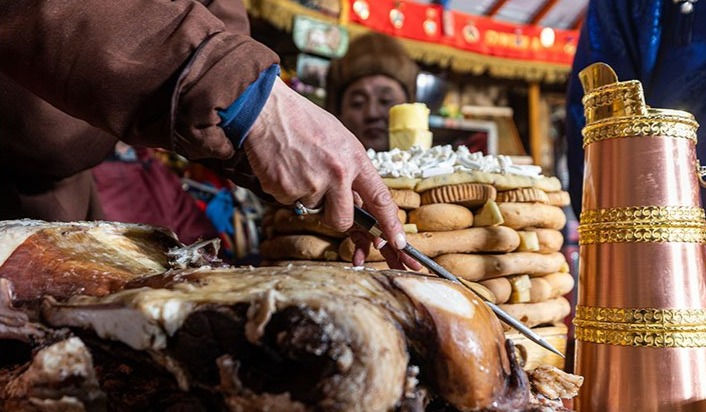Mongolian Lunar New Year Festival customs and rituals
- Tsatsraa

- Jan 24, 2023
- 6 min read
Updated: Dec 26, 2024
Mongolians celebrate the Lunar Month as the passing of one year and a welcoming of a new one. The first day of the New Year is traditionally a popular festival. It is celebrated on a broad nationwide scale. This is the celebration of the passing of the severe winter safe-and-sound and the welcoming of a new year. It is also a celebration of getting wiser. It is an occasion of three festivities. The literal meaning of Lunar Month in Mongolia is 'white'. The white color is the symbol of sincerity and happiness in Mongolian tradition. That is why we call Lunar Month Festival Tsagaan Sar or "White Month. Eco-friendly tours

According to historical chronicles and the research of scholars, Mongolians used to celebrate the Lunar Month festival in the autumn, during which dairy products were available. Today, in contrast, the festival is celebrated at the end of winter and the beginning of spring. The vestige of it exists still among the Kalmuck people. They make a ceremonial zul sar (ghee lamp). Eco-friendly tours
But in the process of history, Mongolians solemnly celebrated Lunar Month at the animal birth period, during which we taste the first dairy products.

Traditionally we do clean on the 29th of the last month of winter as preparatory work (or the Lunar Month festivity. This is a symbol of welcome to the coming year without blemish. On the 30th of the last month (bituun) of winter, we cook a pot of mutton and prepare rendered cream. The cooked molten cakes are piled in three, five, or seven tiers on a big plate. The table is decorated with sweets and other confections. A vessel is filled with fermented mare's milk. All the members of the family gather together and feast all evening to make wassail. Eco-friendly tours The order of arrangement of the whole sheep on a plate: 1. A pot of mutton 2. Breast Eco-friendly tours 3. Fore-leg 4. Hind-leg 5. Cervical vertebrae The mutton includes the sheep's back together with two pieces of ribs and its tail (uuts). The arrangement of sheep's limbs follows the animals' limbs. The breast is placed first on a big plate. Then the vertebrae and forelegs are placed. The front long bones are placed in the wake of the forelegs similar to how a sheep lies down. The mutton is placed upon the arranged limbs of the mutton on the big plate. Then the head and four seared shanks are placed upon the mutton. This is called ikh yosny uuts or 'whole mutton on a plate'. The ears and horns of the sheep are smeared with a skim of milk or ghee. The muzzle of the sheep is placed toward the front of an animal to the west of the mutton. The shinbone is placed toward the vertebrae to the east of the mutton on the plate. The front of the mutton is faced toward the back of the ger. When we offer the mutton, we follow the above-mentioned pattern. This kind of offering of mutton is performed on the occasion of the Lunar Month festival, new ger warmings, and days of commemoration. At the end of sunset, every family starts making tea and prepares for wassail. There is a specific ceremony for this ritual. The head of a family enters and eats the sheep's fibula and picks meat off of the bone. Eco-friendly tours

Then he asks, (can we make wassail?' All the members of the family answer 'yes, it is high time to make wassail'. Then the head of the family takes the marrow out of a broken fibula. Then they say, "The wassail has started, are you enjoying the wassail? " according to the precedence of age. The head of a family or senior person can carve the mutton and distribute it to everybody who is present. Then all the people feast as a ceremony. Eco-friendly tours

The person who carves the mutton can follow the traditional way and set aside a piece of mutton as a share for the hearth. First, he carves both sides of the mutton, then he carves small pieces from both sides and eats them. He then distributes the carved pieces of mutton with his stretched hands to all the members of the family and others as their share of the mutton. Those who are present stretch out their hands and receive them with honor. Eco-friendly tours As soon as the wassail is made at home, they visit their neighbors and ask each other, "Are you enjoying the wassail?" In such a manner, they share their joy and celebration to see off the passing year. This means that they treat their neighbors with their animals' products. In the earlier morning of the next day, every member of every household is in the holiday array.
All the members of the household defer to the most senior person, but the precedence of age is significant. The head of a family, then his wife, then their son or daughter, according to the sequence of age, stretches out both arms with open palms while holding a khadag (sacred scarf) under the arms of a senior person to prop up his or her elbows. Eco-friendly tours

He or she can say 'Are you well?' The senior person can place his or her arms with open palms on the greeter and answer, 'I am well. Are you well? Live long and be happy.' This propping up of the senior person's elbow by a junior person signifies that the junior person shall always treat elders with deference. Eco-friendly tours

After doing their greetings, everyone can sit and exchange their snuff bottles, saying: Did your animals pass the winter well? Are your yearling colts fattening nicely? Are your calves muscled? Are you sheep-tailed? Are your yearling camels' humps upright? In this way, we talk in a rhythmical manner and ask each other's ages. Then we taste dairy products or steamed rice products. After this, the senior person carves two sides of a saddle of mutton and distributes the carved pieces to all gathered at the feast The greeters are treated with tea and food and fermented mare's milk or milk vodka. The enjoyment continues for a while. Eco-friendly tours During the Lunar Month festival, we not only visit our neighbors but also visit our close relatives, even those who live far away. Presents are exchanged. If possible, children who live separately from their parents, endeavor to greet their parents in person within the days of the Lunar Month celebration. Grandsons, granddaughters, and cousins try to greet their paternal and maternal uncles and aunts within the days of this celebration.
There is a view that if your Lunar Month celebration is abundant, your life shall be prosperous in the coming year. So, some of us try to celebrate this festival extravagantly. During it, we play a certain number of games. Children, especially, like to play dibs. There is a certain number of games, such as Durvun berkh (four dibs). Eco-friendly tours

This game is played by casting four dibs 01' game pieces. The games are Arvan khoyor jil (twelve years), maliin zayagaa bodokh (calculation of animal destiny), siiülnii yasaar shodokh (to draw by caudal vertebrae), or a sign of luck, wheel, and üichüür. These games are devoted to testing one's luck. The games range from shooting balls to wrestling to shooting ankle bones to breaking off thoracic vertebrae or straining the cervical vertebrae of a sheep and wrenching a patella as a way of testing one's strength and ability. Eco-friendly tours
Children play games under the guidance of the adults on the night of making wassail. The name of one game is Alag melkhii (multicolored tortoise). Eco-friendly tours

This is played with anklebones, in which the players cast dice in order to capture bones set out in the shape of a tortoise. This game has strict rules of play. The players sit in a semi-circle. The dice are cast. According to spots a player can take off pieces of stacked ankle bones. The player who collects the most ankle bones is the winner, and this person is considered to be lucky in the coming year.
After the ceremony of greeting, Mongolians cast four ankle bones (four dibs) on the morning of the first day of the lunar month festival.
The children play the game called race dibs (anklebones) and adults play a game of twelve dibs (ankle-bones). Eco-friendly tours
The Lunar Month festival was called "livestock breeders feast" because the national tradition had been neglected in Mongolia for 70 years during the twentieth century. On the occasion of the Lunar Month festival, a wrestling match is arranged and other contests are held in Mongolia.
On the days of the Lunar Month festival today, Mongolians wear ceremonial costumes ride in modern cars visit their parents, neighboring villages, and uncles and aunts, and exchange gifts in modern bindings. Eco-friendly tours
HAPPY LUNAR NEW YEAR.













Comments